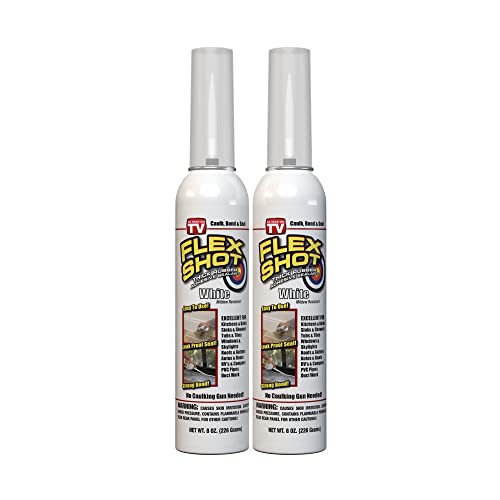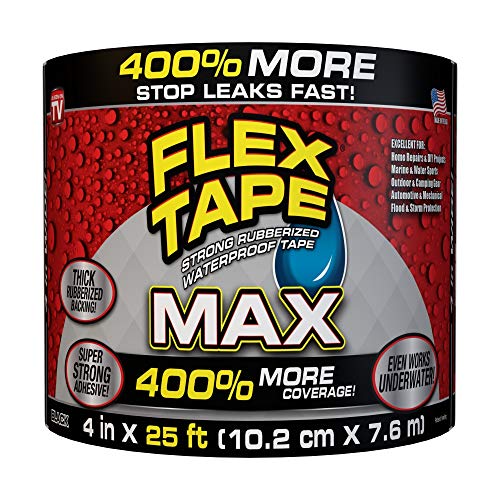As glamorous as the RV lifestyle may appear, dealing with water intrusion and leaky roofs is a rite of passage into the nomadic lifestyle. We would all love for our RVs to be as structurally sound as a brick and mortar house, but unfortunately, they rarely are. RVs need to be as light as possible for interstate travel, and they also need to be affordable. This combination of factors contributes to the relatively weak nature of RVs.
However, don’t let the idea of a leaking roof deter you from purchasing an RV! Almost all leaks can be prevented if the RV is properly cared for. While you will have to direct more energy towards it than a typical house, you’ll thank yourself later down the road when you’re nice and dry inside your rig.
The most crucial part of RV maintenance is properly sealing your RV. With so many products available for the job it can be tough to decide which one is right. Flex Seal is a common box store brand sealant that’s useful in a wide variety of applications. With that, you might be asking yourself – can I use Flex Seal on my RV roof? This article will answer that for you.
Contents
- The Importance of RV Roof Maintenance
- How Often Should I Inspect My RV Roof?
- Common Signs of a Roof Leak
- How to Repair a Roof Leak
- What Type of Sealant Should I Use?
- Can I use Flex Seal on My RV Roof?
- Types of RV Roofs Compatible With Flex Seal
- The Four Types of Flex Seal and When to Use Them
- Advantages of Using Flex Seal
- Downsides of Flex Seal
- What Other Products are Good for RV Roofs?
- Eternabond RoofSeal Tape
- Conclusion: Is Flex Seal Right for Your RV?
The Importance of RV Roof Maintenance
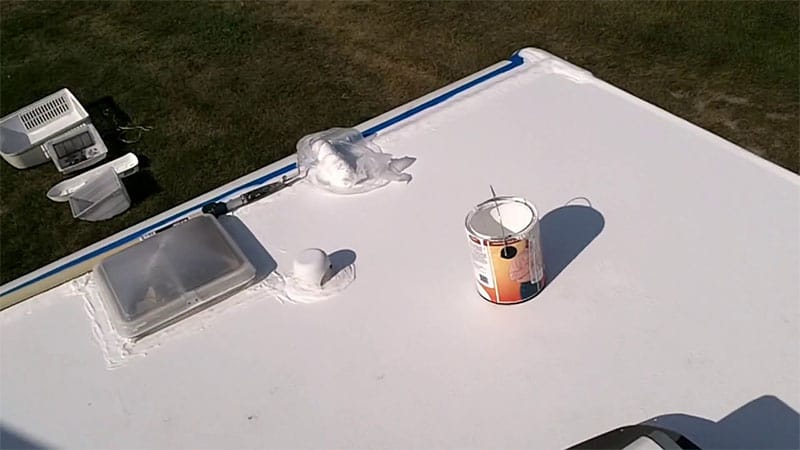
Owning an RV comes with a major responsibility – maintenance. As mentioned, RVs are not always constructed as well as they could be, and it’s up to you to make sure you stay on top of repairs. Ignoring a minor repair can eventually compound, leading to a major expense down the road. This is especially the case with water intrusion.
Water damage is a whole other beast. When water finds a way into your RV, it will sit there until the RV’s roof is fixed. This water can slowly compromise the integrity of your RV as wood rot takes over. Identifying RV roof leaks when they first happen, and taking immediate action, is the best way at extending the life of your rig.
How Often Should I Inspect My RV Roof?
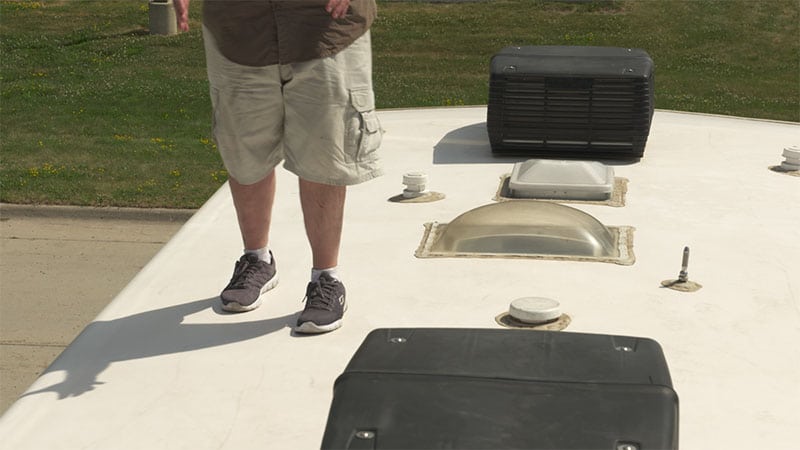
While your RV may not show immediate signs of leaking, you should still periodically inspect your roof. Water can often seep into non-accessible areas of your RV and wreak havoc.
If you’re a full-time RVer that uses their rig year-round, it’s highly recommended that you inspect your roof at least four times a year – or once each season. If you’re a seasonal camper, a thorough inspection at the beginning and end of each season should suffice.
If your inspection turns up any noticeable signs of damage, addressing the situation immediately will greatly reduce your burden down the line.
Common Signs of a Roof Leak
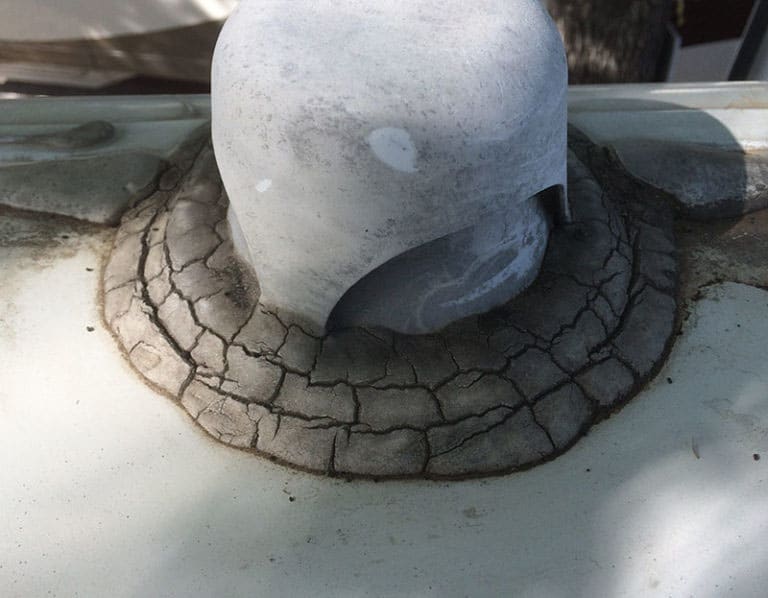
Frequent inspections will help you spot the signs of roofing water leaks pretty early. While not all damage is immediately apparent, there are some tell-tale signs that you’ll need an RV roof repair. These include:
- Ceiling and Wall Water Stains: If you notice yellow or brown spots developing on the inside of your RV, particularly on the ceiling, you’re guaranteed to be dealing with a roof leak. You may also notice discolored streaks running down the walls. This can seem minor, but it’s a major sign you need RV roof repairs.
- Soft Spots: Soft spots on your floor are hard to miss. If you notice that certain areas of your floor seem squishy, or like they might give out under your feet, you’ll need to take immediate action. Usually, this occurs when water damage has been happening for a while, and you’ll likely need to replace that section of the flooring.
- Delamination: Delamination is one of the most obvious signs of a leaky roof. It occurs when water gets in between the membranes of your RV exterior, causing the glue to separate from the body panels. Bubbling and rippling are blatant indicators.
- Cracked Sealant: Cracking sealant, or gaps in your caulking, is an early indicator that water is finding a way into your camper. Addressing this early by reapplying the sealant will eliminate future problems.
How to Repair a Roof Leak
To repair RV roof leaks, you’ll need patience. If damage has gone untouched for quite some time, you may need professional structural repair to replace any rotten framing or flooring. If you’ve caught the leak early, you’ll be relieved to learn that performing a repair is quite simple! All you’ll need is some simple tools, the right sealant, and time.
Most roof leaks are caused by old caulking or sealant that has dried up, cracked, and now allows water to enter the seams of the rig. Replacing it is easy:
- With a razor blade or putty knife, gently scrape off the existing caulking.
- Thoroughly clean the surface with rubbing alcohol; allow to dry.
- Prepare a bucket of warm, soapy water.
- Cut a quarter-inch bead out of the caulking tube; place it in the caulking gun.
- Apply a thin line across the old seal, a couple of feet at a time. Dip your finger in the soapy water and gently run it down the sealant, allowing it to spread outwards.
Always make sure that you’re resealing your RV in favorable weather. Many materials won’t properly seal if the temperature isn’t right, and rain can completely ruin the job!
What Type of Sealant Should I Use?
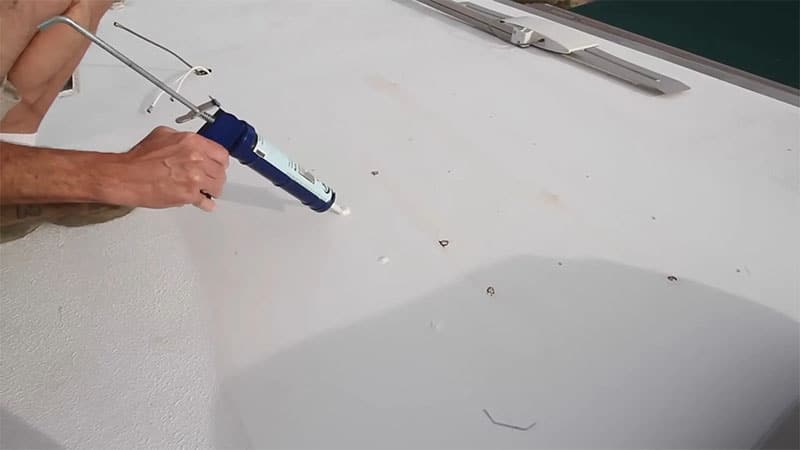
Purchasing the proper sealant for the roof of your RV is imperative. Not all caulking is made universally, and you need to specifically pick a product that’s made for RV applications.
In general, silicone products should always be avoided. An RV is constantly exposed to movement, fluctuating temperatures, variable humidity, and moisture. Silicone caulk easily cracks when put under stress, eliminating its sealing properties. With all the bumping down the road your rig will likely go through, silicone will simply not hold up. Additionally, it cannot be painted, meaning you’ll be forced to deal with whatever color it sets as.
When purchasing a sealant, you’re best off choosing something designed specifically for RVs. These products will be engineered with movement in mind so that cracking will never be an issue. However, finding these types of sealant can be difficult and you’ll have to be near an RV parts store, or have the time to order it online.
With these considerations, many RVers find themselves wondering if they can use alternative products readily found in department stores – like Flex Seal.
Can I use Flex Seal on My RV Roof?
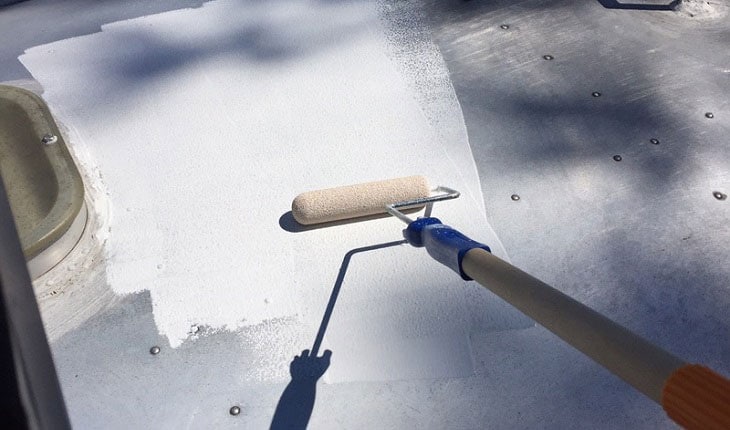
The quick answer to this question is yes. Flex Seal can be used on an RV roof and is entirely safe to do so. It doesn’t contain any properties that will negatively impact the membrane of your roof, and due to its widespread availability, it makes for the perfect option in a pinch.
With this in mind, Flex Seal should not be used as a permanent solution. If your roof has suffered some serious water damage and needs the entire roof serviced, you’re going to want to invest in some longer-term options. However, if you’re strapped for supplies, Flex Seal is an excellent temporary fix for an emergency or short-term repair!
Types of RV Roofs Compatible With Flex Seal
Flex Seal prides itself on being a universal sealant that will adhere to just about anything! This is great news for RVers, as there are a variety of roof material options used by manufacturers. Knowing which type of roof you own is important. By understanding how yours is designed you’ll be able to make informed decisions about maintenance, repair, and replacement.
Let’s look at the four main types of roofs used by RVs today.
TPO Membrane Roof
TPO, otherwise known as thermoplastic polyolefin, is a most commonly used roof material found on RVs. This material was developed in the early 1990s as an alternative solution for flat roofing, but quickly found applications in the motorhome industry.
Compared to other roof types, TPO is extremely affordable and is highlighted by a variety of features that sets it apart. Unlike an EPDM roof which comes black, TPO is naturally white meaning there is no colorization needed during the manufacturer’s process. The material is quite durable, normally lasting for decades, although the lifespan is shorter than EPDM. It can be welded together to form larger sealed sections and is naturally resistant to UV radiation and mold growth.
EPDM Rubber Roof
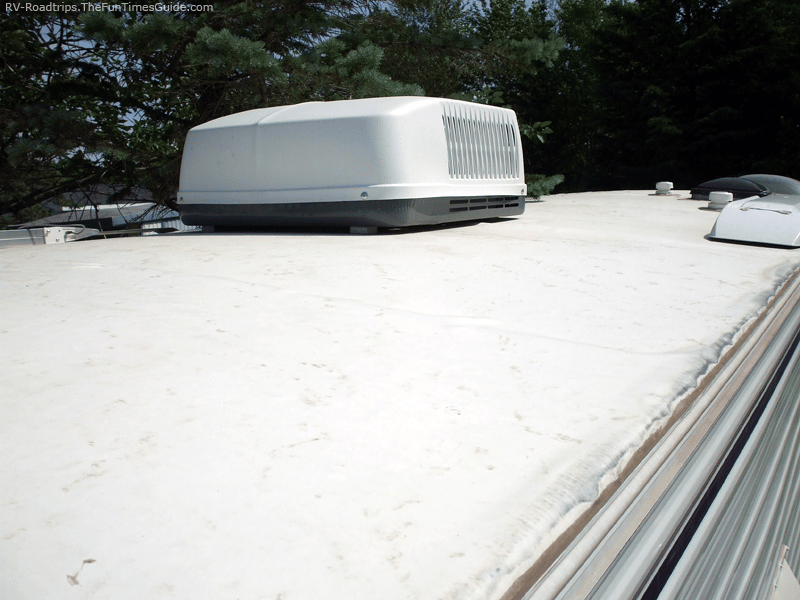
Ethylene propylene diene terpolymer, or EPDM for short, is the most commonly used roof material on RVs. Also used for non-sloping commercial applications, EPDM has an impressive lifespan and normally doesn’t need to be serviced for 10 years at a time. However, the material does tend to oxidize and weaken with age, so proper maintenance is critical. Fortunately, it can be easily recoated with a paint roller.
EPDM has the benefit of being quite resistant to tears and damage, and is inherently flexible, meaning rough travel will never compromise the integrity of the roof.
Fiberglass Roof
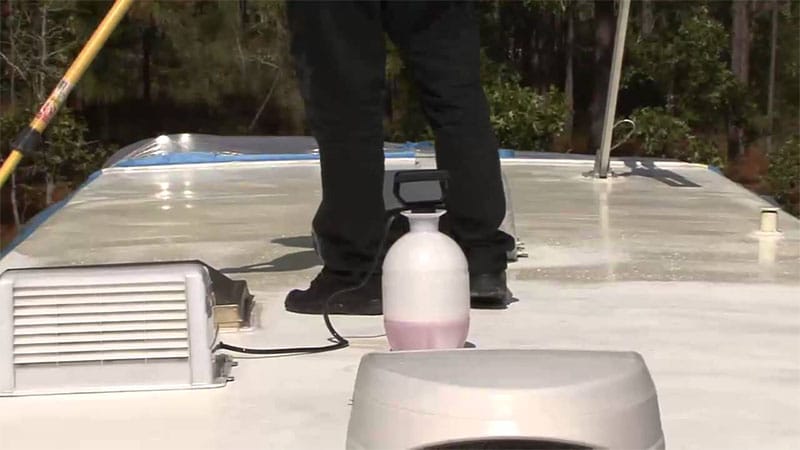
Fiberglass roofs have soared in popularity in recent years due to their impressive resilience and customizability. They’re cost-effective and are much more durable against dings and scratches than rubber roofing. With fiberglass, you won’t ever have to worry about a low-hanging tree branch decimating your roof. Fiberglass also comes in a range of color options, so you can easily veer away from a stock off-white RV.
A downside of fiberglass is that it’s not heat resistant, meaning intense temperatures could potentially damage your roof. When damaged, fiberglass tends to splinter and cannot be easily repaired or resealed. You’ll need to take it to a professional.
Metal Roof
Metal roofing is a thing of the past, but if you own a retro or vintage RV, this is the roof material you’ll likely be dealing with. Normally made of aluminum, metal roofing is heavy and inconveniently mounted with studs. It is however incredibly durable, and Flex Seal has no problem adhering to it.
The Four Types of Flex Seal and When to Use Them
Flex Seal is a household name due to its large advertising budget and eye-catching aisle placement in hardware and department stores. Nearly everyone has heard of it, and its reputation precedes it! What many people don’t know, is that Flex Seal offers multiple products for differing applications. Your choice is completely dependent on the nature of repair you’re trying to accomplish.
Here are the four primary Flex Seal products that can be used by RVers.
Flex Seal Liquid Rubber
Flex Seal Liquid is best used when you need to cover a large area of roofing – particularly rubber roofs. This product comes in various sizes depending on the scope of your job (pint, quart, gallon, or 2.5 gallons), and can easily be poured, painted, or brushed on. Additionally, it comes in four colors – white, black, grey, and clear.
If your RV has a TPO or EPDM rubber roof, Flex Seal Liquid is the best choice for a lasting repair. It seeps into porous surfaces, quickly sealing any gaps or cracks that have occurred. While we normally only recommend flex seal as a temporary fix, many RVers have found success using this as their primary roof sealant.
Flex Seal Spray
Flex Seal Spray is the classic iteration of the Flex Seal family and is extremely convenient to use. It’s applied via an aerosol can and is best used for sealing small-scale surfaces in a pinch. With no brushing or rolling needed, you can easily spray the Flex Seal onto the trouble point of your roof, quickly sealing it within 24 hours.
If you’ve noticed some dings or cracks in your roof and need a speedy repair, Flex Seal spray will do just fine. It is not, however, a permanent repair.
Flex Shot
If you’re looking to make a quick repair to your roof seams, Flex Shot is the way to go. This product resembles caulking and comes in an easy-to-apply tube – no caulking gun required! As with other Flex Seal products, this shouldn’t be used as a permanent sealant, but it works as an excellent temporary repair until you have the time to do a proper caulking job with an RV-rated sealant.
Flex Tape
If your RV has suffered extensive damage and there is a sizable hole in the roof or exterior, you’ll need a solution that provides sturdy coverage and a strong watertight seal. This is where Flex Tape can come in handy. With this product, you can easily stretch the tape across the affected area, and even apply additional sealant over top for maximum security. This combination will ensure that future leaks will be prevented until you can complete a proper repair job. It’s also a perfect option for pesky corner roof seams that have come unadhered.
Flex Tape is also perfect for leaks on more delicate surfaces, like your RV awning. Since the integrity of your awning isn’t as crucial to the overall well-being of your RV, Flex Tape can be a permanent fix when applied properly in this scenario.
Advantages of Using Flex Seal
Compared with other products out there, using Flex Seal has a variety of advantages that validate its impressive reputation:
- Availability: Flex Seal can be readily purchased at any big-box retailer around the country or any local hardware store. Finding RV-specific sealant can often be challenging, and you normally have to visit a dedicated RV store to purchase it – or order online. If you’re away from a major metropolitan area and run into a roof leak, finding Flex Seal will be simple.
- Ease of Use: Flex Seal’s lack of fussiness is tough to match. The product can completely dry and cure in wet environments – even in rainy weather. If we’re being honest, that’s when you need sealant the most. It’s also not as temperature-sensitive as other sealants, meaning you can apply it even if the humidity is high or the outdoor temperatures are low.
Downsides of Flex Seal
The main drawback of using Flex Seal is that it is not a permanent solution for a leaky roof. While it serves as an excellent stopgap, you’ll still need to address the needed repairs that have resulted from water intrusion. While the liquid version of Flex Seal has been used successfully as a permanent coating for an RV roof, this is always done as a preventative measure – not as a corrective one.
Flex Seal is also a petroleum-based product, and rubber roofing may not interact with it as well as other products. While it will certainly adhere, RV-specific sealants designed for EPDM and TPO roofs will be a much longer-term solution.
What Other Products are Good for RV Roofs?
When you have the time and budget, purchasing RV-specific products is always your best option. There are a variety of tried and true sealants that have been used by RVers for years that many travelers swear by. By purchasing these, there will be no question in your mind about whether or not they will work, as they have been specially engineered for motorhome and RV use. Let’s look at some of the most popular options on the market.
Dicor Self-Leveling Sealant
Dicor Self-Leveling Caulk has always been the preferred sealant for RVs and motorhomes and doesn’t require any annoying soapy water to apply. This sealant spreads and levels naturally to ensure a secure water-tight seal on your RV seams. RVers looking to seal the sidewalls of their RV can purchase the non-sagging, non-leveling version so that the caulk doesn’t drip after application.
As renowned as the product is, it does require specific environmental factors and lots of time to set correctly, making it not very useful in an emergency.
Eternabond RoofSeal Tape
Eternabond tape is the go-to product for sealing a leaky area on an RV roof. It’s designed specifically for RV use and requires no other products to seal. Eternabond has zero issues adhering to EPDM or TPO rubber roofs, fiberglass, or metal.
In addition, it’s inherently resistant to UV rays and remains flexible in temperatures down to -70 degrees Fahrenheit, so failure due to cracking is never a problem.
Liquid Rubber RV Roof Coating
While rubber roofs are known for their longevity, most are only rated for ten years of use. If you’ve hit this point, or you own an older RV, resealing your roof should be a priority.
Liquid Rubber RV Roof Coating is the premium choice for the job and can be easily applied with an elongated roller to make the job a breeze. This product is naturally solar resistant, so your roof will receive less UV and absorb less heat. It can be applied in heavy coatings to create multiple membranes of protection, just like your original EPDM finish.
Conclusion: Is Flex Seal Right for Your RV?
Nothing sparks more fear in the minds of RVers than a leaky roof. While normally preventable with proper maintenance, staying up on it can be an arduous process that few travelers have the patience or energy for. If you’ve found that your RV isn’t as watertight as it used to be, or you’ve simply run into some unexpected damage, completing a prompt repair is paramount.
Although a temporary fix in most situations, Flex Seal is a quality product that can stop leaks in their tracks, preventing future repairs down the line. It’s affordable, found in nearly every hardware store across the country, and is safe to use on your RV roof. So, don’t hesitate to pick some up; you’ll never know when you might need it!



